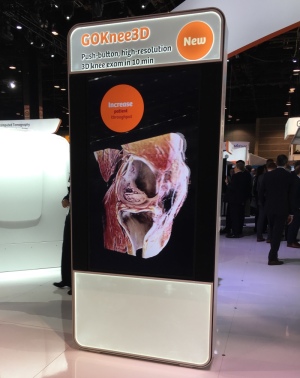por
Lauren Dubinsky, Senior Reporter | November 27, 2017

Siemens' GOKnee3D MR application
on display at RSNA17
CHICAGO -- Siemens Healthineers unveiled its GOKnee3D MR application for the MAGNETOM Skyra 3T and MAGNETOM Aera 1.5T MR systems at the RSNA annual meeting in Chicago this week.
Knee MR exams are typically performed in about 20 minutes, but this new application cuts that time in half.
These exams account for 11 percent of all scans, which makes them the third most common type of MR exam, according to an evaluation Siemens conducted last year. Knee MR exams have also suffered a 16 percent drop in reimbursement in recent years.



Ad Statistics
Times Displayed: 14290
Times Visited: 25 Final days to save an extra 10% on Imaging, Ultrasound, and Biomed parts web prices.* Unlimited use now through September 30 with code AANIV10 (*certain restrictions apply)
“More exams are being done, but [hospitals] are receiving less reimbursement for it,” Daniel Fischer, head of clinical marketing for MR at Siemens, told HCB News.
Because of that, the medical community was in need of an application that would allow them to perform more exams in a shorter amount of time. To fill that need, Siemens teamed up with Johns Hopkins University in Baltimore to develop and clinically validate the GOKnee3D application.
“Johns Hopkins performed 150 patient exams in half the time with no loss in diagnostic information,” said Fischer.
Its fully-automated CAIPIRINHA Space protocol is what enables higher scan speeds as well as better image reconstruction and signal quality compared to previous technologies. It also generates high spatial resolution isotropic data sets to help clinicians visualize abnormalities with high accuracy, make changes to almost any imaging plane, and generate high-quality 3-D MR images.
GOKnee3D features automated field-of-view adaptation based on machine learning and artificial intelligence and dedicated, high-channel knee coils. The user only has to push one button to acquire the volume data of the knee joint.
The application is currently 510(k) pending and not available for sale in the U.S. It’s currently only available for the Skyra and Aera systems, but Siemens expects to roll it out to the rest of its MR fleet over the next few months.

